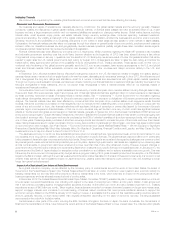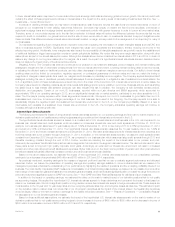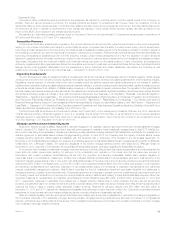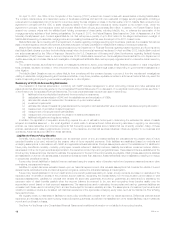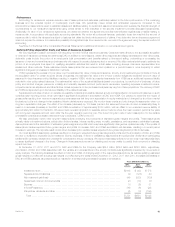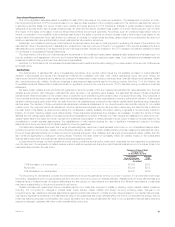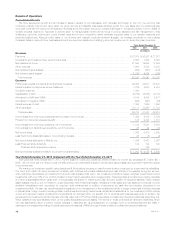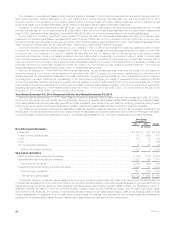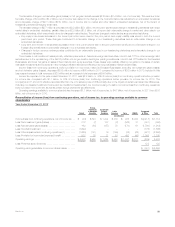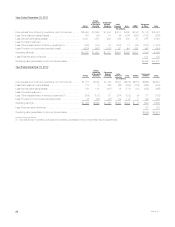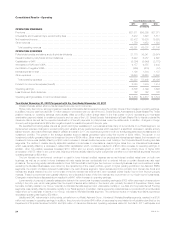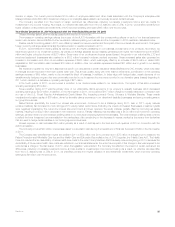MetLife 2012 Annual Report Download - page 23
Download and view the complete annual report
Please find page 23 of the 2012 MetLife annual report below. You can navigate through the pages in the report by either clicking on the pages listed below, or by using the keyword search tool below to find specific information within the annual report.considers only changes in our assumed long-term rate of return given the level and mix of invested assets at the beginning of the year, without
consideration of possible changes in any of the other assumptions described above that could ultimately accompany any changes in our assumed
long-term rate of return.
We determine the discount rates used to value the pension and postretirement obligations, based upon rates commensurate with current yields on
high quality corporate bonds. Given our pension and postretirement obligations as of December 31, 2011, the beginning of the measurement year, if
we had assumed a discount rate for both our pension and postretirement benefit plans that was 100 basis points higher or 100 basis points lower than
the rates we assumed, the change in our net periodic benefit costs would have been a decrease of $133 million and an increase of $153 million,
respectively, in 2012. This considers only changes in our assumed discount rates without consideration of possible changes in any of the other
assumptions described above that could ultimately accompany any changes in our assumed discount rate. The assumptions used may differ materially
from actual results due to, among other factors, changing market and economic conditions and changes in participant demographics. These
differences may have a significant effect on the Company’s consolidated financial statements and liquidity.
See Note 18 of the Notes to the Consolidated Financial Statements for additional discussion of assumptions used in measuring liabilities relating to
our employee benefit plans.
Income Taxes
We provide for federal, state and foreign income taxes currently payable, as well as those deferred due to temporary differences between the
financial reporting and tax bases of assets and liabilities. Our accounting for income taxes represents our best estimate of various events and
transactions. These tax laws are complex and are subject to differing interpretations by the taxpayer and the relevant governmental taxing authorities. In
establishing a provision for income tax expense, we must make judgments and interpretations about the application of these inherently complex tax
laws. We must also make estimates about when in the future certain items will affect taxable income in the various tax jurisdictions, both domestic and
foreign.
The realization of deferred tax assets depends upon the existence of sufficient taxable income within the carryback or carryforward periods under the
tax law in the applicable tax jurisdiction. Valuation allowances are established when management determines, based on available information, that it is
more likely than not that deferred income tax assets will not be realized. Factors in management’s determination include the performance of the
business and its ability to generate capital gains. Significant judgment is required in determining whether valuation allowances should be established, as
well as the amount of such allowances. When making such determination, consideration is given to, among other things, the following:
(i) future taxable income exclusive of reversing temporary differences and carryforwards;
(ii) future reversals of existing taxable temporary differences;
(iii) taxable income in prior carryback years; and
(iv) tax planning strategies.
Disputes over interpretations of the tax laws may be subject to review and adjudication by the court systems of the various tax jurisdictions or may
be settled with the taxing authority upon audit. We determine whether it is more likely than not that a tax position will be sustained upon examination by
the appropriate taxing authorities before any part of the benefit is recorded in the financial statements. We may be required to change our provision for
income taxes when estimates used in determining valuation allowances on deferred tax assets significantly change, or when receipt of new information
indicates the need for adjustment in valuation allowances. Additionally, future events, such as changes in tax laws, tax regulations, or interpretations of
such laws or regulations, could have an impact on the provision for income tax and the effective tax rate. Any such changes could significantly affect the
amounts reported in the consolidated financial statements in the year these changes occur.
See Note 19 of the Notes to the Consolidated Financial Statements for additional information on our income taxes.
Litigation Contingencies
We are a party to a number of legal actions and are involved in a number of regulatory investigations. Given the inherent unpredictability of these
matters, it is difficult to estimate the impact on our financial position. Liabilities are established when it is probable that a loss has been incurred and the
amount of the loss can be reasonably estimated. Liabilities related to certain lawsuits, including our asbestos-related liability, are especially difficult to
estimate due to the limitation of available data and uncertainty regarding numerous variables that can affect liability estimates. The data and variables that
impact the assumptions used to estimate our asbestos-related liability include the number of future claims, the cost to resolve claims, the disease mix
and severity of disease in pending and future claims, the impact of the number of new claims filed in a particular jurisdiction and variations in the law in
the jurisdictions in which claims are filed, the possible impact of tort reform efforts, the willingness of courts to allow plaintiffs to pursue claims against us
when exposure to asbestos took place after the dangers of asbestos exposure were well known, and the impact of any possible future adverse verdicts
and their amounts. On a quarterly and annual basis, we review relevant information with respect to liabilities for litigation, regulatory investigations and
litigation-related contingencies to be reflected in our consolidated financial statements. It is possible that an adverse outcome in certain of our litigation
and regulatory investigations, including asbestos-related cases, or the use of different assumptions in the determination of amounts recorded could
have a material effect upon our consolidated net income or cash flows in particular quarterly or annual periods.
See Note 21 of the Notes to the Consolidated Financial Statements for additional information regarding our assessment of litigation contingencies.
Economic Capital
Economic capital is an internally developed risk capital model, the purpose of which is to measure the risk in the business and to provide a basis
upon which capital is deployed. The economic capital model accounts for the unique and specific nature of the risks inherent in our business.
Our economic capital model aligns segment allocated equity with emerging standards and consistent risk principles. Segment net investment
income is credited or charged based on the level of allocated equity; however, changes in allocated equity do not impact our consolidated net
investment income, operating earnings or income (loss) from continuing operations, net of income tax.
Acquisitions and Dispositions
See Notes 3 and 23 of the Notes to the Consolidated Financial Statements.
MetLife, Inc. 17



